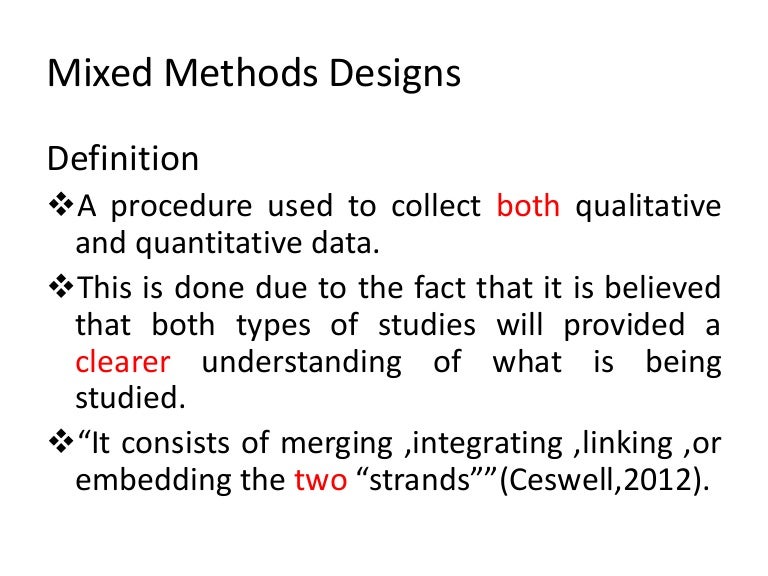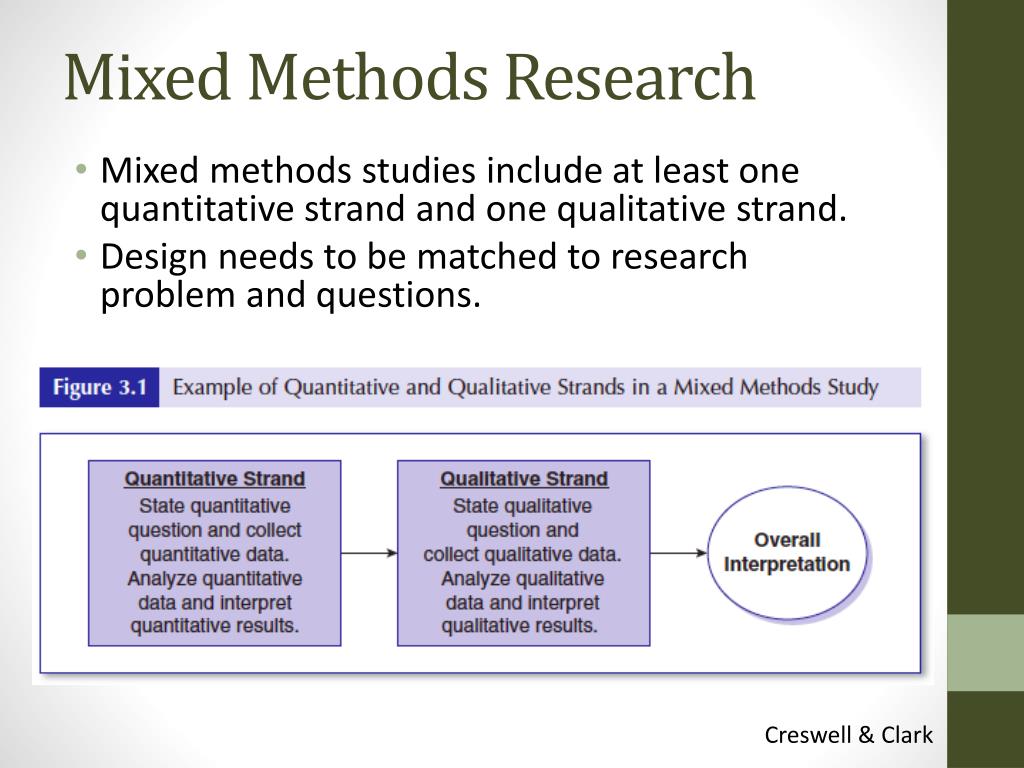Table Of Content

They envision an MMR methodology that can function as a “guide” for selecting specific methods. For instance, Morgan (2007) and Hesse-Biber (2010) consider pragmatism as a philosophy that distinguishes MMR from qualitative (constructivism) and quantitative (positivist) research and that can provide a rationale for the paradigmatic pluralism typical of MMR. The question whether a terminological shift has occurred from “multiple methods” to “mixed methods” must be answered affirmative for this sample. Prior to 2001 most articles (23 out of 31) refer to “multiple methods” or “multi-method” in their title or abstract, while the term “mixed methods” gains traction after 2001. This shift occurs first in journals in nursing studies, with journals in education studies following somewhat later. Some authors state that design typologies are particularly useful for beginning researchers and interactive approaches are suited for experienced researchers (Creswell and Plano Clark 2011).
3 Data analysis
Fielding, meanwhile, has written two articles for the JMMR (Fielding and Cisneros-Puebla 2009; Fielding 2012). This framework makes it possible to contextualize the emergence of MMR in a socio-historical way. It also enables an assessment of some of the characteristics of MMR as a scientific product, since Bourdieu insists on the homology between the objective positions in a field and the position-takings of the agents who occupy these positions. As a new methodological approach, MMR is the result of the position-takings of its producers. Possible rewards include a strengthened autonomy of the subfield of MMR and an improved position in the social-scientific field.

Interventions
The present study introduces an understandable, applicable, and valid guideline for obstetric telephone triage. This guideline is the first obstetric telephone triage guideline designed in Iran, which is based on the modified Emergency Severity Index (ESI) obstetric triage [41]. In a study conducted in the United States of America to develop a telephone triage of candidiasis diagnosis, Hoffstetter et al. (2012) showed that it is difficult to diagnose candidiasis using symptoms and self-report through telephone triage as well as telephone treatment in symptomatic women. However, a telephone symptom guide for the diagnosis of candidiasis increased the accuracy of treatment by telephone triage [42]. While obstetric telephone triage guidelines are intended to guide triage personnel, they should not reduce their decision-making ability or professional responsibility and should be consistent with the patient’s professional insights and preferences.
Sample Mixed Methods Research Study
They could then use the results to explore any conflicting or differing results, allowing them to gain a deeper understanding of job satisfaction at the company. The flexibility of mixed methods research designs means that researchers can choose any combination of the four frameworks outlined above and other methodologies, such as convergent parallel, explanatory sequential, and exploratory sequential, to suit their particular needs. An example of this could be a study that involves forming focus groups with participants who actively develop the research questions and then provide feedback during the data collection and analysis stages.
Dimension of complexity
A study protocol for a European, mixed methods, prospective, cohort study of the effectiveness of naloxone ... - BMC Public Health
A study protocol for a European, mixed methods, prospective, cohort study of the effectiveness of naloxone ....
Posted: Thu, 24 Aug 2023 07:00:00 GMT [source]
In addition, they assume that the core component should always be performed either concurrent with or before the supplemental component. We leave it to the reader to decide if he or she desires to conduct a qualitatively driven study, a quantitatively driven study, or an equal-status/“interactive” study. According to the philosophies of pragmatism (Johnson and Onwuegbuzie 2004) and dialectical pluralism (Johnson 2017), interactive mixed methods research is very much a possibility.

The mixed method analysis of this convergent parallel study design occurred at the interpretation phase (21). The quantitative tables were triangulated with the themes in the qualitative matrices and areas of convergence and divergence were explored. For example, the administrative data analysis showed how participants are redeeming CVB, the breakdown of redemption rates among racial/ethnic groups, and urbanicity.
Both WIC State and local agencies indicated the uncertainty of the exact changes to CVB amounts and the timing of those changes, which created difficulties for CVB implementation. With limited time to correct the benefit amount that was already programmed, some State and local agency staff had to manually reissue the correct amount. This created an excess burden on WIC staff to reissue the correct benefit amount to participants. When reaching out to local agencies to participate in the interviews, we also asked if they would promote the WIC caregiver interview through their preferred communication channels (e.g., social media, texting, flyers in the clinic, etc.). We provided local agencies with a digital flyer and offered to mail a hard copy flyer to post in their clinics. The flyer included the study telephone number and email where interested respondents could contact the research team to complete the interview.
Similar content being viewed by others
It also has the potential to cost more than conducting a stand alone qualitative or quantitative study. You may find differing or even conflicting results by combining quantitative and qualitative data. It is up to the researcher to then carefully analyze the results and consider them in the context of the research question to draw meaningful conclusions. Obstetric physical triage is an independent and efficient unit [11, 12] with versatile dimensions such as parturient admission, evaluation of fetal well-being, as well as acute obstetric and gynecological emergencies [13]. Triage ensures appropriate care based on the clinical priorities of the patient and the effective use of resources [14, 15]. However, some problems of obstetric triage include patient dissatisfaction and prolonged waiting times [16,17,18].
The final validation of the guideline was carried out based on the opinions of experts in terms of applicability (93%), scientific (90%), and importance (100%). Table 2 shows the validity and quality of the developed guideline based on the AGREE II tool (Table 2). According to the experts’s opinion, the score obtained in all domains of the AGREE II tool was above 60%, so the designed guideline has a content validity. Not applicable—no identifying images or other personal or clinical details of participants are presented here or will be presented in reports of the trial results. All data from this research will be deidentified and made available in a public data repository (TBD).
All the members of Leech’s selection, except for Morse, and the members of Creswell’s selection (except Hunter, Brewer, and Fielding) are represented in the selection based on the entries in the JMMR.Footnote 5 The same holds for two of the three additional authors identified by Creswell. Hunter and Brewer have developed a somewhat different approach to combining methods that explicitly targets data gathering techniques and largely avoids epistemological discussions. In Brewer and Hunter (2006) they discuss the MMR approach very briefly and only include two references in their bibliography to the handbook of Tashakkori and Teddlie (2003), and at the end of 2013 they had not published in the JMMR.
Thus far, 360 unhoused individuals have been matched to a phone buddy from across the two intervention groups (169 in Miracle Friends only and 191 in the Miracle Money group), with 56 people still not matched. Of the 191 study participants in the Miracle Money group who were initially matched to a volunteer phone buddy, 103 were verified as participating in Miracle Friends and began receiving monthly income and 70 people were not selected because they were not participating in Miracle Friends. One person withdrew from the study and we were unable to contact 17 others in the Miracle Money group who had been initially matched with a Miracle Friend. Themes from the caregiver of WIC participants interviews centered around their awareness, satisfaction, and utilization of the CVB changes with relevant quotes included to support the findings. Supplementary Figure S1 provides a conceptual model for the various dynamic relationships of the WIC community across the qualitative findings.
We also recommend that researchers understand the process approach to design from Maxwell and Loomis (2003), and realize that research design is a process and it needs, oftentimes, to be flexible and interactive. Each true mixed methods study has at least one “point of integration” – called the “point of interface” by Morse and Niehaus (2009) and Guest (2013) –, at which the qualitative and quantitative components are brought together. Having one or more points of integration is the distinguishing feature of a design based on multiple components. It is at this point that the components are “mixed”, hence the label “mixed methods designs”. The term “mixing”, however, is misleading, as the components are not simply mixed, but have to be integrated very carefully.
Themes from the WIC State and local agency interviews related to CVB barriers and facilitators are discussed below. The i-PARIHS subconstructs and relevant quotes are included as applicable with additional details available in Supplementary Tables S2–S5, S10. For more detail of the evaluation guide, refer to the McMaster University Mixed Methods Appraisal Tool.12 The quality checklist for appraising published mixed methods research could also be used as a design checklist when planning mixed methods studies.
Recent cash-value benefit (CVB) increases are a positive development to help increase WIC participant fruits and vegetables (FV) access. Little is known about the impacts of the CVB changes on FV redemptions or about implementation successes and challenges among WIC State and local agencies. This mixed method study aimed to evaluate (a) the CVB changes’ impact on FV access among WIC child participants measured by CVB redemption rates, (b) facilitators and barriers to CVB changes’ implementation, and (c) differences in FV redemption and facilitators and barriers by race/ethnicity. Not all applied researchers have insight into the underlying philosophy and/or the skills to apply each set of methods appropriately. Younas and colleagues’ review identified that around one-third (29%) of mixed-methods studies did not provide an explicit label of the study design and 95% of studies did not identify the research paradigm [7].
No comments:
Post a Comment